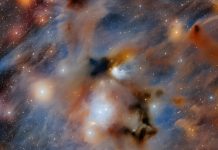
Neptune and Uranus are similar in size and atmospheric conditions but curiously, Neptune is a darker shade of blue.
Astronomers used observations from the international Gemini Observatory, a program of NSF’s NOIRLab, the NASA Infrared Telescope Facility and Hubble Space Telescope to develop an atmospheric model that explains the difference in hue between the icy planets.
The researchers concluded the lighter hue of Uranus is the result of haze in the planet’s stagnant atmosphere.
The astronomers noted that if the atmospheres of the two planets were free of haze their color would appear almost identical.
The model the team developed aligns with observations of reflected sunlight and includes haze particles in deeper layers of the atmosphere.
“This is the first model to simultaneously fit observations of reflected sunlight from ultraviolet to near-infrared wavelengths,” said Patrick Irwin, lead author of the paper.
“It’s also the first to explain the difference in visible color between Uranus and Neptune.”
The team noted that the model predicts the haze is dispersed more quickly by Neptune’s turbulent middle atmosphere, resulting in its deeper blue hue.
“We hoped that developing this model would help us understand clouds and hazes in the ice giants’ atmospheres,” said Mike Wong, one of the authors of the study.
“Explaining the difference in color between Uranus and Neptune was an unexpected bonus.”
The team analyzed observations of Neptune and Uranus from the Near-Infrared Integral Field Spectrometer on the Gemini North Telescope — part of the international Gemini Observatory – and archival data from the NASA Infrared Telescope Facility and Hubble Space Telescope to create the model.
“The international Gemini Observatories continue to deliver new insights into the nature of our planetary neighbors,” said Martin Still, director of NSF’s Gemini Observatories program.
“In this experiment, Gemini North provided a component in a suite of ground- and space-based facilities critical to the detection and characterization of atmospheric hazes.”



